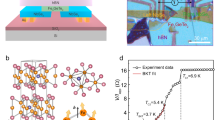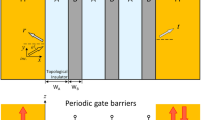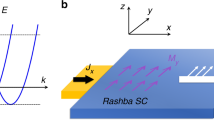Abstract
A superconducting spin valve consists of a thin-film superconductor between two ferromagnetic layers. A change of magnetization alignment shifts the superconducting transition temperature (ΔΤc) due to an interplay between the magnetic exchange energy and the superconducting condensate. The magnitude of ΔΤc scales inversely with the superconductor thickness (dS) and is zero when dS exceeds the superconducting coherence length (ξ). Here, we report a superconducting spin-valve effect involving a different underlying mechanism in which magnetization alignment and ΔΤc are determined by nodal quasiparticle excitation states on the Fermi surface of the d-wave superconductor YBa2Cu3O7–δ sandwiched between insulating layers of ferromagnetic Pr0.8Ca0.2MnO3. We observe ΔΤc values that approach 2 K with the sign of ΔΤc oscillating with dS over a length scale exceeding 100ξ and, for particular values of dS, the superconducting state reinforces an antiparallel magnetization alignment. These results pave the way to all-oxide superconducting memory in which superconductivity modulates the magnetic state.
This is a preview of subscription content, access via your institution
Access options
Access Nature and 54 other Nature Portfolio journals
Get Nature+, our best-value online-access subscription
$29.99 / 30 days
cancel any time
Subscribe to this journal
Receive 12 print issues and online access
$259.00 per year
only $21.58 per issue
Buy this article
- Purchase on Springer Link
- Instant access to full article PDF
Prices may be subject to local taxes which are calculated during checkout




Similar content being viewed by others
Data availability
Supporting research data has been deposited in the University of Cambridge research repository and is publicly available at https://doi.org/10.17863/CAM.37835.
References
Baibich, M. N. et al. Giant magnetoresistance of (001)Fe/(001)Cr magnetic superlattices. Phys. Rev. Lett. 61, 2472–2475 (1988).
Binasch, G., Grunberg, P., Saurenbach, F. & Zinn, W. Enhanced magnetoresistance in layered magnetic structrues with antiferromagnetic interlayer exchange. Phys. Rev. B. 39, 4828–4830 (1989).
de Gennes, P. G. Coupling between ferromagnets through a superconducting layer. Phys. Lett. 23, 10–11 (1966).
Meservey, R., Tedrow, P. M. & Fulde, P. Magnetic field splitting of the quasiparticle states in superconducting Al films. Phys. Rev. Lett. 25, 1270–1272 (1970).
Tedrow, P. M., Tkaczyk, J. E. & Kumar, A. Spin-polarized electron tunnelling study of an artificially layered superconductor with internal magnetic field: EuO-Al. Phys. Rev. Lett. 56, 1746–1749 (1986).
Li, B. et al. Superconducting spin switch with infinite magnetoresistance induced by an internal exchange field. Phys. Rev. Lett. 110, 097001 (2013).
Zhu, Y., Pal, A., Blamire, M. G. & Barber, Z. H. Superconducting exchange coupling between ferromagnets. Nat. Mater. 16, 195–199 (2017).
Moraru, I. C., Pratt, W. P. Jr & Birge, N. O. Magnetization-dependent T c shift in ferromagnet/superconductor/ferromagnet trilayers with a strong ferromagnet. Phys. Rev. Lett. 96, 037004 (2006).
Flokstra, M. G. et al. Controlled suppression of superconductivity by the generation of polarized Cooper pairs in spin-valve structures. Phys. Rev. B. 91, 060501(R) (2015).
Miao, G.-X., Ramos, A. V. & Moodera, J. S. Infinite magnetoresistance from the spin dependent proximity effect in symmetry driven bcc-Fe/V/Fe heteroepitaxial superconducting spin valves. Phys. Rev. Lett. 101, 137001 (2008).
Cadden-Zimansky, P. et al. Asymmetric ferromagnet-superconductor-ferromagnet switch. Phys. Rev. B 77, 184501 (2008).
Zhu, J., Krivorotov, I. N., Halterman, K. & Valls, O. T. Angular dependence of the superconducting transition temperature in ferromagnet-superconductor-ferromagnet trilayers. Phys. Rev. Lett. 105, 207002 (2010).
Potenza, A. & Marrows, C. H. Superconductor-ferromagnet CuNi/Nb/CuNi trilayers as superconducting spin-valve core structures. Phys. Rev. B. 71, 180503 (2005). (R).
Gu, Y., Halasz, G. B., Robinson, J. W. A. & Blamire, M. G. Large superconducting spin valve effect and ultrasmall exchange splitting in epitaxial rare-earth-niobium trilayers. Phys. Rev. Lett. 115, 067201 (2015).
Yu, A., Rusanov, S., Habraken, S. & Aarts, J. Inverse spin switch effects in ferromagnet-superconductor-ferromagnet trilayers with strong ferromagnets. Phys. Rev. B. 73, 060505 (2006).
Hu, T. et al. Stray field and spin-imbalance effects in La0.7Ca0.3MnO3/YBa2Cu3O7-δ multilayers. Physica 430B, 1167–1169 (2008).
Van Zalk, M., Veldhorst, M., Brinkman, A., Aarts, J. & Hilgenkamp, H. Magnetization-induced resistance-switching effects in La0.67Sr0.33MnO3/YBa2Cu3O7-δ. Phys. Rev. B. 79, 134509 (2009).
Steiner, R. & Ziemann, P. Magnetic switching of the superconducting transition temperature in layered ferromagnetic/ superconducting hybrids: spin switch versus stray field effects. Phys. Rev. B. 74, 094504 (2006).
Peña, V. et al. Giant magnetoresistance in ferromagnet/superconductor superlattices. Phys. Rev. Lett. 94, 057002 (2005).
Nemes, N. et al. Origin of the inverse spin-switch behavior in manganite/cuprate/manganite trilayers. Phys. Rev. B. 78, 094515 (2008).
Pang, B. S. H., Bell, C., Tomov, R. I., Durrell, J. H. & Blamire, M. G. Pseudo-spin valve behavior in oxide ferromagnet/superconductor/ferromagnet trilayers. Phys. Lett. A. 341, 313 (2005).
Visani, C. et al. Spin-dependent magnetoresistance of ferromagnet/superconductor/ferromagnet La0.7Ca0.3MnO3/YBa2Cu3O7-δ/La0.7Ca0.3MnO3 trilayers. Phys. Rev. B. 75, 054501 (2007).
Welp, U., Kwok, W. K., Crabtree, G. W., Vandervoort, K. G. & Liu, J. Z. Magnetic measurements of the upper critical field of YBa2Cu3O7-δ single crystals. Phys. Rev. Lett. 62, 1908–1911 (1989).
Komori, S., Di Bernardo, A., Buzdin, A. I., Blamire, M. G. & Robinson, J. W. A. Magnetic exchange fields and domain wall superconductivity at an all-oxide superconductor/ferromagnetic insulator interface. Phys. Rev. Lett. 121, 077003 (2018).
Wu, G. et al. Superconducting anisotropy in the electron-doped high-Tc superconductors Pr2-xCexCuO4-y. J. Phys.: Condens. Matter 28, 405701 (2014).
Dagan, Y., Beck, R. & Greene, R. L. Dirty superconductivity in the electron-doped cuprate Pr2-xCexCuO4-δ tunnelling study. Phys. Rev. Lett. 99, 147004 (2007).
Kalcheim, Y. et al. Magnetic field dependence of the proximity-induced triplet superconductivity at ferromagnet/superconductor interfaces. Phys. Rev. B. 89, 180506 (2014).
Cacovich, S. et al. Unveiling the chemical composition of halide perovskite films using multivariate statistical analysis. ACS Appl. Energy Mater. 1, 7174–7182 (2018).
Dho, J. et al. Two ferromagnetic transitions in Pr0.8Ca0.2MnO3. Solid State Commun. 123, 441–444 (2002).
Guiblin, N., Grebille, D., Martin, C. & Hervieu, M. Praseodymium magnetic contribution in the low temperature structure of Pr0.8Ca0.2MnO3. J. Solid State Chem. 177, 3310–3315 (2004).
Peña, V. et al. Spin diffusion versus proximity effect at ferromagnet/superconductor La0.7Ca0.3MnO3/YBa2Cu3O7-δ interfaces. Phys. Rev. B. 73, 104513 (2006).
Sefrioui, Z. et al. Ferromagnetic/superconducting proximity effect in La0.7Ca0.3MnO3/YBa2Cu3O7-δ superlattices. Phys. Rev. B. 67, 214511 (2003).
Kosztin, I. & Legget, A. J. Nonlocal effects on the magnetic penetration depth in d-wave superconductors. Phys. Rev. Lett. 79, 135–138 (1997).
Ruderman, M. A. & Kittel, C. Indirect exchange coupling of nuclear magnetic moments by conduction electrons. Phys. Rev. 96, 99–102 (1954).
Acknowledgements
A.D.B., S.K. and J.W.A.R. acknowledge funding from the EPSRC through the International Network grant no. EP/N017242/1. A.D.B. acknowledges funding from St John’s College, Cambridge. J.W.A.R. acknowledges funding from the Royal Society.
Author information
Authors and Affiliations
Contributions
J.W.A.R. supervised the project and with A.D.B. conceived and designed it. A.D.B. prepared the samples and performed electrical and magnetic measurements with help from S.K. TEM imaging and compositional analysis were performed by G.D. The theoretical model was developed by M.C and P.G. with support from G.L. and input from A.D.B. and J.W.A.R. The paper was written by A.D.B., J.W.A.R. and M.C. with input from all authors.
Corresponding authors
Ethics declarations
Competing interests
The authors declare no competing interests.
Additional information
Publisher’s note: Springer Nature remains neutral with regard to jurisdictional claims in published maps and institutional affiliations.
Supplementary information
Supplementary Information
Supplementary Figs. 1–19, Notes 1–4 and refs. 1–31.
Rights and permissions
About this article
Cite this article
Di Bernardo, A., Komori, S., Livanas, G. et al. Nodal superconducting exchange coupling. Nat. Mater. 18, 1194–1200 (2019). https://doi.org/10.1038/s41563-019-0476-3
Received:
Accepted:
Published:
Issue Date:
DOI: https://doi.org/10.1038/s41563-019-0476-3
This article is cited by
-
Local control of superconductivity in a NbSe2/CrSBr van der Waals heterostructure
Nature Communications (2023)
-
Anomalous Josephson coupling and high-harmonics in non-centrosymmetric superconductors with S-wave spin-triplet pairing
npj Quantum Materials (2022)
-
Self-consistent solution for the magnetic exchange interaction mediated by a superconductor
Scientific Reports (2021)



